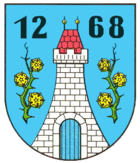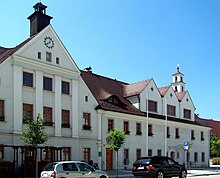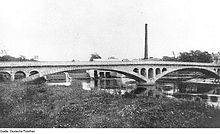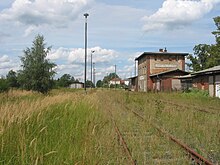Rothenburg / Upper Lusatia
| coat of arms | Germany map | |
|---|---|---|

|
Coordinates: 51 ° 20 ' N , 14 ° 58' E |
|
| Basic data | ||
| State : | Saxony | |
| County : | Goerlitz | |
| Management Community : | Rothenburg / OL | |
| Height : | 160 m above sea level NHN | |
| Area : | 72.4 km 2 | |
| Residents: | 4458 (Dec. 31, 2019) | |
| Population density : | 62 inhabitants per km 2 | |
| Postal code : | 02929 | |
| Primaries : | 035891, 035892 (Uhsmannsdorf) | |
| License plate : | GR, LÖB, NOL, NY, WSW, ZI | |
| Community key : | 14 6 26 480 | |
| LOCODE : | DE RBO | |
| City structure: | City center and 8 districts | |
City administration address : |
Marktplatz 1 02929 Rothenburg / Oberlausitz |
|
| Website : | ||
| Mayoress : | Heike Böhm ( SPD ) | |
| Location of the city of Rothenburg / Oberlausitz in the district of Görlitz | ||
Rothenburg / Oberlausitz (official name Rothenburg / OL ; Upper Lusatian : Ruttnburg , Upper Sorbian ) is a small town in the district of Görlitz in the northeast of the Free State of Saxony on the German- Polish border. Following the example of Görlitz , it calls itself “Germany's easternmost small town” and “Germany's easternmost town”.
The University of Applied Sciences for Police of the Free State of Saxony has had its headquarters here since 1995. To the north-west of the city lies the Rothenburg / Görlitz airfield , which was built in the 1960s and used by the NVA as a fighter pilot training station.
geography
The city is located in the eastern part of the district in the valley of the Lausitzer Neisse south of the Muskauer Heide . Rothenburg is surrounded by a strongly agricultural and forestry landscape.
history
The city was first mentioned in 1268 in a document from Margrave Otto von Brandenburg . The foundation was probably at the end of the 12th and beginning of the 13th century. The development was characterized by handicrafts and agriculture in an economically rather barren surrounding area. A total of 13 devastating city fires went through the city. The local von Martin family, who owned a large part of the arable land around Rothenburg, dominated the town and its development.
Sorbian was also spoken in Rothenburg until the second half of the 17th century , although there were no more Sorbian services after the Reformation. A small church at the cemetery that was only demolished in 1931, however, has been popularly known as the “Wendenkapelle” until recently.
The city fell to Prussia in 1815 according to the resolutions of the Congress of Vienna . With the Prussian administrative reform, it became the district town of the Rothenburg district (Ob. Laus.) , Which was one of the largest districts in Prussia and later Germany. At the end of the 19th century the still important diaconal institutions Martinshof (until 1941 Zoar ) and the Martin-Ulbrich-Haus (orthopedic clinic, formerly Schlesisches Krüppelheim) were founded. The Tormersdorf area of Martinshof on the other side of the Neisse was confiscated in 1941 and converted into a Tormersdorf collective and labor camp for Jews from the Görlitz and Breslau area, before they were deported to the east for mass execution.
Towards the end of the Second World War, the 2nd Polish Army formed a bridgehead several times during the Neisse crossing near Rothenburg. The city and Tormersdorf were severely damaged by the fighting.
Because of its peripheral location on the German outer border as a result of the Potsdam resolutions, Rothenburg lost its district seat to the much larger city of Weißwasser in 1945 , the district name changed accordingly to the district of Weißwasser. After the merger with the western part of the old district of Görlitz to form the district of Weißwasser-Görlitz , Niesky became its district town in 1947. As part of the administrative reform of 1952 , new districts and districts were formed, Rothenburg was now in the Niesky district ( Dresden district ).
In the 1960s, the emergency landing site of the former air force was expanded into a fighter pilot training area for the air forces of the National People's Army . Due to the influx of soldiers' families, the number of residents increased sharply. The training squadron had to be closed in 1990, if only because of its location within the 30 km border corridor to Poland.
Part of the 1907-built and in the 1960's disused railway line Horka-Przewóz was upgraded in late 2008 for a restart. After the insolvency of the pellet plant at Rothenburg / Görlitz airfield , which is important for freight traffic, the train service was no longer operational.
Development of the municipality area
Local division
Rothenburg consists of the town of Rothenburg, which was founded in the Middle Ages, and the village of Noes, which has grown into it . Seven more villages have been incorporated into several municipal and administrative reforms. In addition, the scattered settlements Kahle Meile, Spreehammer and Ungunst belong to the city.
Incorporations
The following surrounding villages were incorporated as districts (from north to south):
- Steinbach
- Lodenau
- Neusorge (with the Spreeaufwurf settlement )
- Bremenhain
- Dunkelhäuser (settlements originally spread across Noes, Rothenburg and Uhsmannsdorf)
- Enclosure
- Nieder-Neundorf
- Uhsmannsdorf
Population development
Rothenburg's population (only the city of Rothenburg and Noes) rose from 3500 to 5500 inhabitants between 1970 and 1990 because of the local NVA training squadron. After 1990 the population decreased. At the end of 2013 the population was 4,741.
politics
City council
The city council election on May 26, 2019 led to the following result in the distribution of votes and, accordingly, the 16 seats to the individual groups:
| Party / list | Share of votes | +/-% p | Seats | +/- |
| CDU | 44.9% | - 15.5 | 8th | - 2nd |
| The left | 13.8% | - 9.4 | 2 | - 2nd |
| AfD | 16.5% | + 16.5 | 2 | + 2 |
| FWV | 19.5% | + 3.1 | 3 | + 1 |
| Flat share Uhsmannsdorf | 5.3% | + 5.3 | 0 | - |
| total | 100% | 15th | ||
|---|---|---|---|---|
| Turnout: 60.3% (2014: 48.7%) | ||||
Town twinning
Rothenburg has had a partnership with the small town of Dransfeld in Lower Saxony since 1991 . Eleven years later, another partnership was concluded with the small Polish town of Pieńsk ( Penzig ). The special thing here is that the two Neisse cities are only about 15 km apart.
Rothenburg is in a friendship alliance with other Rot (h) enburgs: Rothenburg ob der Tauber (Bavaria), Rotenburg an der Fulda (Hesse), Rotenburg (Wümme) (Lower Saxony), Rothenburg (Saale) (Saxony-Anhalt), Rothenburg LU ( Switzerland), Czerwieńsk ( Rothenburg an der Oder , Poland). At the church level, there were already some relationships with Rothenburg ob der Tauber in the GDR times.
Culture and sights
The cultural monuments are recorded in the list of cultural monuments in Rothenburg / Oberlausitz .
Churches
- Evangelical town church
After the great city fire of 1798, the completely burned-out Gothic previous building was demolished. On June 8, 1799, the foundation stone was laid for a new building, initially without a tower, which was consecrated on April 15, 1805. In 1817 the church received an organ and in 1823 the Nazarene Adolf Zimmermann, who was born in the parish, donated the still existing altarpiece "Jesus with the disciples in Emmaus". In 1838 the foundation of the Görlitzer merchant and former owner of the Rothenburg manor Christian Friedrich v. Schrickell in the amount of 2000 thalers and a gift of grace from the Prussian King Friedrich Wilhelm III. The foundation stone of the tower was laid for 500 Talers. The Görlitz master mason Gustav Kießler directed the construction work on the 60 m high tower . On December 16, 1840, the bell could be raised, but it had to be delivered as a metal donation for armaments purposes during the First World War . Between February and April 1945 the church tower suffered severe damage as a result of the heavy fighting at the end of the Second World War, parts of the tower collapsed into the nave and the organ and interior were damaged. Since the reconstruction in the 1950s, the church tower has only been around 45 m high. In 1982 it was covered with copper. The picture Bible designed by the community in the nave on the first gallery and the crypt of the landowners family v. Martin.
- Catholic Church of St. Maria Regina Rosarii
Memorials
- A thougts on the site of Martin Court recalls since 1988 to set up a ghetto for 700 Jews from the cities of Silesia on the grounds of the Martin court in neighboring Tormersdorf who perform in war-important business forced labor had and from 1942 to the Theresienstadt concentration camp and Auschwitz and Majdanek concentration camp were extradited to be killed.
- At the intersection in front of the entrance to Martinshof there has been a memorial since 1945 in memory of the communist district council member Herbert Balzer , who was murdered in the Gleina subcamp .
- There is a tank monument at the southern entrance to Rothenburg . It commemorates the liberation of the place in April 1945. On the plaque below the Soviet T34 tank is written in German, Russian and Polish: "Historic site of the struggle for our liberation by the Soviet Army and the 2nd Polish Army in April 1945" .
Leisure and sports facilities
city Park
The development of the Rothenburg City Park can be traced back to the 15th century. At that time there was already the palace garden on the north side of the palace, which represents something like the first stage in the development of the park. Around 1750 a baroque pleasure garden was created with flower beds, water features and a hedge labyrinth. Adolf Freiherr von Gersdorf had the garden redesigned based on the English model , and in 1883, with the new owner Friedrich von Martin, the park and estate complex were perfected by around 1900. After 1945 it was looked after by the “Rothenburger Park” working group. The city park has been an attractive point of attraction for visitors to the town until recently.
The park has a size of about 20 hectares. Below the church there is a crypt, which is adorned by a stately cast-iron gate. Friedrich von Martin and his first wife Martha were buried here. They are said to have made great contributions to the well-being of the citizens of their time. A cultural facility with an open-air stage and other leisure facilities of the city of Rothenburg can be found in the park. Old oaks, hornbeams, beeches, aspen and huge elms are in the complex and indicate a considerable age. A black poplar overgrown with ivy is particularly noticeable. Overall, the park impresses with its mighty trees such as maple, silver linden, chestnut, silver maple, huge ancient alders and oaks that define the banks of the Neisse waters. In 1926, the floods at the time caused damage to the weir located there, so that it only carries back-dammed water.
The landscape park is a member of the garden culture trail on both sides of the Neisse . This improves the possibilities of care ( park seminars ) and the prospects for funding and tourist development.
Other systems:
- Cycling along and boating on the Neisse
- The cultural island of Einsiedel is about ten kilometers south .
- Sports complex in the north of the city with a swimming pool, sports field, tartan track, tennis hall, judo hall and much more
- Gym with Jahnsportplatz near the center
Regular events
- The Rothenburg Summer Festival takes place every year on the first weekend in August. It is one of the largest folk festivals in East Saxony.
- The traditional Christmas market takes place on the weekend of the 4th Advent.
- Neisse Adventure Race (NAR) - a team event as a sporty four-way battle leads up to 100 teams through the central Ausitz in May
- Every year in the week around Ascension Day the "Days of Speed and Thunder" take place with international participation.
Economy and Infrastructure
Social and medical institutions
- Martinshof Rothenburg Diakoniewerk - non-profit foundation (medical care, care for the elderly, care of disabled people, etc.), with more than 600 employees one of the largest employers in the Görlitz district
- Orthopedic center "Martin-Ulbrich-Haus gGmbH" - hospital with a focus on orthopedics and specialist clinic for rehabilitation
Educational institutions
- Elementary school Rothenburg
- "Moritz Zimmermann" high school
- University of the Saxon Police (FH)
Airfield
The Rothenburg / Görlitz airfield, which has meanwhile been released for civil aviation, is the contact point for several clubs, including the Rothenburger Luftsportverein, which has already achieved numerous successes. The association operates a 3000 m long rope laying stretch for high altitude wind starts , which is one of the longest in Germany. Glider pilots and parachutists meet for numerous events throughout the year on the former NVA airfield.
The Pulso meeting, which is known beyond the borders, takes place every year. Here model airplanes reach speeds of up to 430 km / h. In 2017, a Guinness World Record was even set for the second time for the fastest remote-controlled model airplane (RC) with jet propulsion, which reached a speed of 749.221 km / h.
Personalities
- Johann Friedrich Gregorius (1697–1761), Protestant theologian and hymn poet, senior pastor in Rothenburg
- Moritz Zimmermann (1804–1876), head of the Rothenburg City School
- Wigand von Gersdorff (1851–1920), Prussian lieutenant general
- Alfred von Martin (1882–1979), historian and sociologist
- Paul Rentsch (1898–1944), dentist and resistance fighter; Righteous among the peoples
- Siegfried Bruchholz (1927–2012), head forester, author of biological and forestry publications
- Iris Wittig (1928–1978), first female military pilot in the GDR
- Reinhard Leue (1929–2012), Protestant theologian, publicist, author and chronicler - he lived in Rothenburg from 1987–2012 and worked from 1987–1994 as the director of what is now Martinshof Rothenburg Diakoniewerk
- Bernd Lange (* 1956), politician (CDU), district administrator of the district of Görlitz
- Philipp Schober (* 1987), show jumper
literature
- Ludwig August Theodor Holscher: Brief topography and history of the district town of Rothenburg in the Preuss. Upper Lusatia . Gocksch & Hentschel, Rothenburg O./L. 1844 ( book text and digitized version at Wikisource ).
- Reinhard Leue : Two sisters on the Neisse - Article with a historical-chronistic background about Sänitz and the Rothenburg district of Steinbach . Published twice: a) pp. 59–64 in Memorized Heritage. Studies on the Silesian and Upper Lusatian Church History , Volume 8, Festschrift for Christian-Erdmann Schott. Edited by Dietrich Meyer, Association for Silesian Church History e. V., Herrnhut 2002, ISBN 3-9807955-1-9 , DNB 966374630 and b) pp. 165–168 in Oberlausitzer Hausbuch 2001 , Bautzen 2002, ISBN 3-929091-88-7 , DNB 01641182X
- Steffen Menzel, Ulrich Werner: Rothenburg. Pictures of an old district town. ASS-GmbH, Horka 1994.
- Author collective: Park guide through Upper Lusatia. Lusatia Verlag, Bautzen 1999, ISBN 3-929091-56-9 .
Web links
- Rothenburg / Upper Lusatia
- Rothenburg / Oberlausitz in the Digital Historical Directory of Saxony
- Landscape park on the homepage of the garden culture path on both sides of the Neisse
Individual evidence
- ↑ Population of the Free State of Saxony by municipalities on December 31, 2019 ( help on this ).
- ↑ www.oberlausitzer-woerterbuch.de
- ↑ CDLS I : LVIII (pp. 92–95) , here: Rotenberg on p. 93, line 17 .
- ^ Frido Mětšk : On the question of the German-Sorbian language borders of the 16th century in the Margraviate of Upper Lusatia and in the Stolpen office. In: Lětopis , Series B, No. 7 (1960), Ludowe nakładnistwo Domowina, Budyšin 1960, pp. 83–132.
- ↑ www.wahlen.sachsen.de: Results of the local elections 2019 - Rothenburg / Oberlausitz
- ↑ Homepage garden culture path on both sides of the Neisse, members and cooperation partners , accessed on June 4, 2018
- ↑ Days of Speed and Thunder
- ↑ Personnel & Positions , Martinshof
- ↑ About us , Martinshof
- ↑ a b August Moritz Zimmermann (born September 17, 1804 in Lodenau; † 1876), brother of Adolf Zimmermann , took over the rectorate of the Rothenburg city school on an interim basis in 1839 and after appointment in 1840. (See also Ludwig August Theodor Holscher: Brief topography and history of the district town of Rothenburg in Prussia. Upper Lausitz . Gocksch & Hentschel, Rothenburg O./L. 1844, p. 69 ( Wikisource ). ) The high school has had his name since 2002.
- ↑ Rothenburger Luftsportverein e. V. Accessed August 6, 2018 .
- ↑ Video: German pilot builds RC model airplane with jet propulsion that reaches almost 750 km / h . In: Guinness World Records . March 13, 2018 ( guinnessworldrecords.de [accessed August 6, 2018]).









